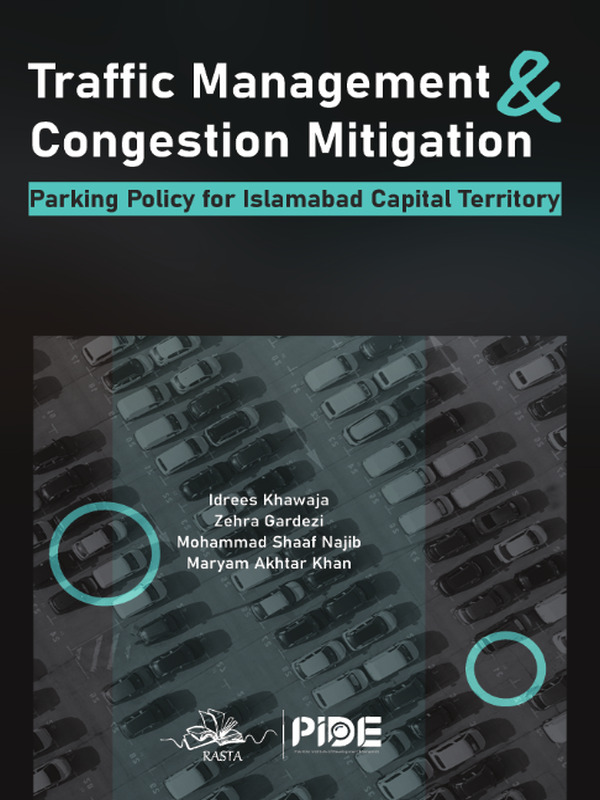Traffic Management & Congestion Mitigation Parking Policy for Islamabad Capital Territory
EXECUTIVE SUMMARY
Free parking is a subsidy to car owners in the sense that motorists undervalue the cost of driving resulting in car use beyond the optimal level. This imposes several costs on society in the form of traffic congestion, urban sprawl, greater consumption of energy, and pollution. Evidence suggests that paid parking reduces car use, yet the policy response to more cars on the roads has been to increase the number of parking spaces – thus instead of demand management, the focus is on augmenting the supply. Parking spaces are developed on valuable urban land that has competing uses, hence there should be a limit on land that can be allocated to parking – pricing the parking land will determine the limit. Provision of free parking causes people to park for an extended time which makes other motorists cruise for parking space, increasing road congestion, energy consumption, and time lost in finding parking – this ‘tragedy of the commons’ situation can be avoided by introducing paid parking. We argue that just as car owners pay for fuel, insurance, and servicing of their vehicles, they should pay for the cost of parking as well. A parking fee must be charged to reflect, at least to some degree, the value of the space occupied by the parkers. Bringing about change is always difficult. The car owners will have to be convinced about the benefits of paid parking – lesser congestion, better air quality, and above all a greater chance to find a parking space, if one must commute by car. The shop owners and other businesses concerned about possible adverse impacts on their business will have to be convinced that in fact, in the medium term, the business is likely to increase if people find it easier to commute and park. Awareness campaigns, with the stakeholders, will have to be convened to create the buy-in required.
CONTENTS
Foreword……………………………………………………………………………………………………………i
Acknowledgments…………………………………………………………………………………………..iv
Executive Summary………………………………………………………………………………………v
Contents………………………………………………………………………………………………………..xi
List of Tables……………………………………………………………………………………………………xiii
List of Figures…. ………………………………………………………………………………………..xiii
List of Boxes……………………………………………………………………………………………xiv
List of Maps………………………………………………………………………………………………..xiv
List of Abbreviations………………………………………………………………………………..xv
1. THE RATIONALE FOR PAID PARKING……………………………………………………1
1.1. Pre-Requisites……………………………………………………………………………….5
2. SITUATION ANALYSIS AND WILLINGNESS TO PAY……………………………..9
2.1. Methodology ……………………………………………………………………………….9
2.2. Findings…………………………………………………………………………………….10
3. CONCEPT DESIGN FOR PAID PARKING…………………………………………….26
3.1. Salient Features of Designated Parking……………………………………..26
3.2. Conceptual Layout Plan for a Parking Lot in Blue Area………………37
4. PAYMENT AND ENFORCEMENT MECHANISM……………………………………42
4.1. Making Payment For Parking…………………………………………………………42
4.2. Integration of Parking Data…………………………………………………………..49
4.3. Monitoring, Surveillance, and Enforcement………………………………..49
4.4. Way Forward…………………………………………………………………………………50
5. PUBLIC TRANSPORT……………………………………………………………………………..52
5.1. The Current State of Public Transport…………………………………………53
5.2. Existing Bus Routes & Expansion Plans………………………………………53
5.3. Way Forward – Additional Bus Routes……………………………………….54
5.4. Sector-Wise Public Transport Connectively……………………………….58
6. RECOMMENDATIONS FOR CONGESTION MITIGATION IN
ISLAMABAD……………………………………………………………………………………………….67
Traffic Management & Congestion Mitigation
6.1. High Occupancy Vehicle (HOV) Lanes………………………………………….68
6.2. Car Pooling To Work – Implementation Options…………………………68
6.3. Congestion Pricing……………………………………………………………………….69
6.4. Reversible Lanes……………………………………………………………………………70
6.5. Car Rationing………………………………………………………………………………….71
CONCLUSION……………………………………………………………………………………………………….72
References……………………………………………………………………………………………………………..73
Appendices…………………………………………………………………………………………………………….75
APPENDIX A – Data collection…………………………………………………………………………….75
Maps of Parking Locations……………………………………………………………………………………76
APPENDIX B – Parking standards……………………………………………………………………..100




